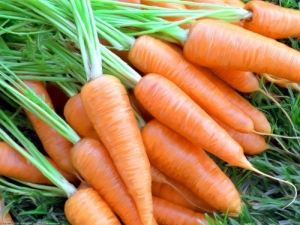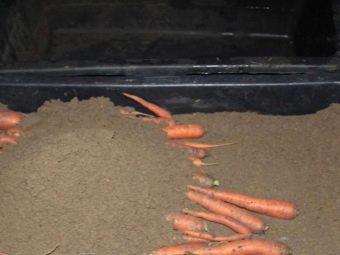Carrots "Shantane": features, types and subtleties of cultivation

Carrots belong to the umbrella family and is a biennial plant. In the second year, a stem appears that adorns a small flower.In it seeds are tied, having collected which, it is possible to grow up a crop again. Carrots contain a huge amount of nutrients. The variety "Chantonne" was bred in France and for seven decades of its existence, the variety has gained popularity on all five continents.
Characteristic
This agricultural crop is grown both on large plantations and in private farms. Ripens "Shantane" within 12-14 weeks. Up to 10 kg of crop is harvested from one square meter. It has an attractive appearance, good characteristics and reviews.
The fruits of this variety are hardy, well withstand temperature fluctuations, have resistance to cracking. Options:
- carrot diameter - up to 6 cm;
- length - up to 15 cm;
- weight - up to 200 g
The fruits are completely in the ground, bright orange in color, have considerable density. One hundred grams of the product contains up to 24 mg of carotene, a high sugar content (up to 10%). The most famous subspecies of the variety:
- “Shantane 2461”;
- "Shantane Royal";
- Shantane Royal;
- Kuroda Shantane;
- Chicago F1;
- Shantane Kuroda;
- "Shantane Skvirskaya";
- "Shantane Red Heart";
- Red Cred.
The latter variety differs from the others in its high content of vitamins and microelements. All of them are grown in approximately the same conditions, but there are small differences in agricultural technology. A lot of healthy dishes are made from carrots, this product is irreplaceable in the diet of young children.
Carrots have long been used to heal wounds and abscesses. Description and healing properties of this product are found in Novgorod chronicles from the XIV century.
It is worth remembering that excessive doses of carotene can be harmful to health. When this element is too much in the body, the skin becomes covered with yellow spots, there is dysfunction in the work of the internal organs.
Varieties
Carrots "Kuroda" - is an early hybrid, which is widespread among farmers. It has high yield, resistance to low temperatures. Fruits have juicy dense pulp, their length can be 20 centimeters and more. "Kuroda" can be stored for a long time. The shape of the carrot is cone-shaped with blunt ends, the diameter is 3-5 cm. The yield reaches 400 kg per hectare.
Carrots "Red Kor" is considered early ripe, it is distinguished by a good yield. Fruits appear 12 weeks after the first shoots. Root vegetables are relatively small, up to 15 cm. Carrots have a large percentage of sugar and do not taste bitter. The variety "Shantali" is grown in the open field, planted in April.
Advantages:
- perfectly tolerates negative temperatures;
- has a high yield;
- resistant to pests.
Variety "Shantane Royal" is considered mid-season. Ripens 15 weeks after germination. The plant has a vertical orientation; fruits do not have lateral roots. "Royal" does not need special care. The length of root crops can reach two dozen centimeters, weight - up to a quarter of a kilogram. The variety can be stored for a long time, it has a good keeping factor. The percentage of carotene in Royal is high, but sometimes individual fruits can crack.
"Shantane 2461" is intended for winter sowing. This is a very durable variety, does not deform at harvest time, is stored for a long time. The plant has good resistance to parasites, especially white scab. It is from this variety that Shantane carrots spread throughout Russia. It ripens within 14 weeks, the fruits weigh up to 200 grams and reach a length of 16 cm.
“Shantane Korolevskaya” grows in the European part of Russia, the vegetative period takes 12-14 weeks. Fruits contain a significant amount of carotene (up to 15 mg per one hundred grams of product). Shantane “Korolevskaya” has a record yield (up to 12 kg per square meter), which is 25% higher than the classic variety “Shantane 2461”.
“Shantane Komet” is a variety that can be called sredneranny, the roots are strong, they can withstand considerable mechanical loads during transportation and harvesting. "Shantane Komet" has good resistance to pests.
“Shanate Victoria” ripens very quickly, has similar characteristics with the variety “Komet”.
“Shantane Ablako F1” is used for the production of juices. Carrots have an amazing ability not to lose useful qualities after processing, it is well stored. Often, "Shantane Ablako F1" is used in the perfume industry.
How to plant?
Before planting carrots "Shantane", you must prepare the furrows with a depth of 4.5 cm, they are filled with seeds. The excavation is filled up, the soil is compacted slightly, the landing site is watered from a watering can. This variety of carrot loves well-lit areas. In central Russia, landing is done in mid-April, in the southern regions of the country - at the end of March.
Carrots "Shantane" - culture unpretentious, care for her is simple. Weeding and watering are not strictly regulated, are performed as needed. In this case, only a hoe is required from the tools, which penetrates the earth to a small depth. Carrot roots are located close to the surface, this fact should be taken into account.
Feedings are made every two weeks. With the appearance of the first shoots, fertilizing is done with superphosphates (1 tablespoon is diluted in a bucket of water), sometimes urea is added. The resulting mixture watered beds.
The composition for the second feeding consists of nitrophoska (a tablespoon of the chemical is dissolved in a 6.5 liter tank). The third dressing consists of ash solution (three tablespoons of ash per half a bucket of water). The fourth is two grams of boric acid, which is diluted in a bucket of water.
Carrots "Shantane" should be in the ground completely, it is an indispensable condition of agricultural technology. If, for some reason, the tip of a root crop sticks out of the ground, it should always be sprinkled, as sunlight adversely affects the taste of the fruit.
Early carrot varieties have a ripening period of two months, mid-season species - 3-4 months, in late varieties the vegetative period can last 4 months or more. Planting time is decided individually. It is recommended to germinate carrots whose seeds were planted in the winter in the first half of April. In such cases, a small structure covered with a film (in form it resembles a miniature house) is placed above the garden where the seedlings are located, then intensive watering follows.
Harvesting and Storage
It is required to take into account the safety period of each variety. Early varieties are usually sown in the middle lane in the second half of April. If the root crop is supposed to be stored for a long time, then it is required to plant it in May. In such cases, they are usually planted in mid-ripening or late ripening varieties. When harvesting, each fruit is cleared of the ground, neatly folded in boxes. If there is full ventilation in the basement, then carrots can be stored without problems throughout the winter.
Plant "Shantane" should be in areas that are well lit by sunlight. The exact dates of harvesting carrots can not be called even by people who have many years of experience growing this crop. They depend on such factors:
- root crop variety and size;
- the climate where the plant grows;
- planting dates.
Before harvesting, individual specimens of carrots are dug up and studied. According to the test root crops, we can conclude how ripe the harvest. If there are small roots on carrots, then carrots can be collected. This is usually done in the second half of September.
When harvesting tools, forks and bayonet shovels are used. After drying the tops are cut, re-grading is performed. It is important to make the correct sorting, choosing for long-term storage only strong roots.
Carrots are stored in sandboxes, sawdust of coniferous trees is also allowed.You can store carrots in plastic bags, but it is recommended not to close them and make side holes in them for air exchange to occur.
It is allowed to pour a little lime into the bag, which removes excessive moisture.
Carrots are also interspersed with onion and garlic peel. Standard carrot storage times may vary:
- in a tank with sawdust in the basement - 1 year;
- in a tank with sand in the cellar - 10 months.
Care
Choose for carrots recommended "light" soils that have good characteristics in terms of permeability. On clay soils to get a big harvest will not succeed. When planting, it is recommended to apply organic fertilizer to the soil. Bird droppings provoke the appearance of diseases in plants, reduces the sugar content in root crops, therefore it cannot be used as a fertilizer for carrots.
It should be time to thin out the plants. This is done after the formation of the third sheet. Between sprouts there should be a distance of about 2.4 cm. After the thinning is completed, plants are usually fed with urea. The second thinning is done four weeks after the first. It is necessary to do this so that carrot bushes do not interfere with each other’s development. Thinning is done in the early morning before sunrise. It is also necessary during this process to remove all weeds that interfere with good nutrition of the root system of cultivated plants.
How to store carrots at home, see the following video.



































